Shoes are the most capricious item in a wardrobe, because during use they become dusty, dirty, and exposed to temperature changes, cold and sun. If you do not take proper, constant care, after a few months your favorite shoes or boots will lose their attractive appearance. Considering that shoes are expensive, it makes sense to provide complete care, which includes not only cleaning, but also drying, treating with special products and proper storage.
What does shoe care include?
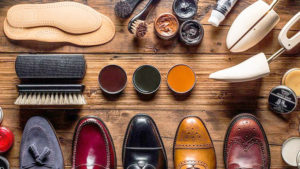 First of all, you need to put on your shoes with the help of a horn; you cannot take off your shoes or boots with one foot resting on the other. Let's talk about other stages of care in more detail.
First of all, you need to put on your shoes with the help of a horn; you cannot take off your shoes or boots with one foot resting on the other. Let's talk about other stages of care in more detail.
Cleaning. Any shoes should be cleaned immediately after returning home so that dirt does not dry on the soles and spoil the appearance. You need to wash it quickly so that it does not get wet; excess moisture harms any material.
Cleaning recommendations are as follows:
- remove the insoles and laces, dry them separately;
- dry shoes or boots, providing access to the soles (the drying process lasts at least 24 hours);
- minor dirt is removed with a brush or a damp cloth, and then dry;
- if you don’t have special tools at hand, you can quickly rinse under running water;
- the cream must match the material and its shade; it is best to apply the composition at night so that it is completely absorbed;
- the next day it is enough to polish the surface;
- Wipe the inner surface regularly to avoid the appearance of fungus;
- the sole should be lubricated with vegetable oil (prevents drying out and cracking).
Important! It is prohibited to use aggressive detergents containing chlorine. Also, you cannot clean the surface with a silicone sponge - they are impregnated with a special compound that harms leather and suede.
Secrets of cleaning different materials:
- Genuine leather is cleaned immediately to prevent dirt from drying out. Wet and dry wipes, running water or soap solution are used if the contamination is severe.
- Textiles and synthetics are cleaned with a soft brush (you can use a sponge). Textile sports sneakers are washed in warm water (not higher than +35 degrees), after which they need to be rinsed thoroughly.
- It is more difficult to care for nubuck and suede; they can only be cleaned in a dry state using metal, rubberized tools. For treatment, special impregnations and aerosols are used; after application, the surface is wiped with a suede stone, then combed in one direction. For additional protection, apply a water-repellent compound to suede or nubuck once a month.
Interesting fact! Shiny areas can be rubbed with bread crumbs, salt or part of a matchbox with sulfur.Brown suede can be rubbed with coffee grounds, and smoking over a candle will help restore the presentation of black suede. It is best to straighten the pile over steam.
- Plastic boots are cleaned with Vaseline for a beautiful shine and protection from cracks.
- Black satin shoes just need to be wiped with a cotton swab dipped in strong coffee.
- Felt boots are cared for using a stiff brush or sandpaper.
- Felt is treated with talcum powder.
Good to know! If shoes have not been used for a long time, they can easily be restored to their attractive appearance. Lacquered leather is rubbed with Vaseline, leather with glycerin, rubber with vegetable oil.
Drying. Basic Rules:
- dry away from heat sources only at room temperature;
- Place the pads inside; if they are not there, use plain paper.
To keep the shoes soft, after drying they need to be treated with Vaseline, and after a few hours - with shoe polish.
At what temperature should you dry shoes made of different materials?
| Material | Drying temperature |
| Leather and nubuck | The best way is to wipe dry with a flannel cloth and dry at room temperature. |
| Felt boots | +90 degrees |
| Felt | +50 degrees |
| Rubber boots | Wipe dry and dry at room temperature |
| Snowboots | Can be dried on a radiator (placed on a warm surface with a fabric base) or with an electric dryer |
Important! Wash your insoles regularly - this is a necessary disinfection and an important stage of care.
Polishing and impregnation. Waxes, creams, and aerosols are used for polishing. The main goal is to give the surface a rich shade and shine. The product is distributed with a brush (the best choice is a brush with natural bristles). Then rub the surface with a dry cloth.Another method of polishing is to treat the surface with cream, apply a little water and rub with a cotton napkin. For impregnation, products with a water-repellent effect are used.
Processing agents. All natural materials are sensitive to chemical components. Using low-quality products, be prepared that your shoes will lose performance over time: strength, elasticity, texture. In addition, the wax protects the seams from getting wet even without the use of an aerosol.
Important! The optimal choice, according to experts, is colorless wax with a natural composition. Please note that the composition must contain beeswax or mink oil.
Before application, please read the instructions carefully. The cream is applied to the dried surface with a brush (sponge). It will take at least half an hour for absorption, but it is better to leave the shoes overnight.
Since it is not recommended to wet the skin frequently, it is necessary to wash it with soapy water after 2-3 treatments with cream (it is applied every day).
A few recommendations:
- for processing, a product is selected for a specific material;
- if the shoes are multi-colored, use a toothbrush to treat different areas;
- to care for light-colored shoes, choose a colorless cream;
- The skin should not be lubricated with Vaseline or vegetable oil, as a result the material will become dull.
Good to know! Experts do not recommend cleaning shoes in shopping centers using automatic brushes, since the bristles of the brushes are most likely synthetic and the cream is of low quality.
Storage. Before storage, shoes must be disinfected from the inside. It is best to purchase special pads; they prevent deformation. If there are no lasts, stuff the shoes with paper so that there are no wrinkles on the surface.
The storage area must be regularly ventilated to prevent the formation of mold and mildew. You cannot use plastic boxes or plastic bags for storage - without access to oxygen, the material becomes dull and hard.
How to properly care for shoes depending on their material
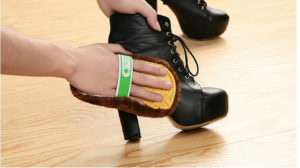 Genuine Leather. Before first use, the surface is treated:
Genuine Leather. Before first use, the surface is treated:
- protective composition;
- cream of the appropriate shade.
Dirt is removed with a dry brush, then with a damp cloth, and skin shampoos are also used.
Forbidden! Use aggressive detergents and wet the skin heavily.
Patent leather. Such shoes can only be worn at temperatures not lower than -100C, not higher than +250WITH. For treatment, patent leather products and dry, soft wipes are used. To avoid deformation, patent leather shoes are stuffed with paper. Special oil or spray polish gives a beautiful shine.
Forbidden! Clean the varnish surface with a brush.
Velours. Before first use, apply a protective composition for suede to the surface. Dust and stains are removed with a rubber brush. Then apply a product for velor or suede and lift the pile with a brush. The best product for everyday care is spray paint for suede.
Forbidden! Wear velor shoes in the rain.
Nubuck. Should be cleaned regularly and a protective agent for suede or nubuck should be applied before first use. Dry at room temperature or using a dryer. Why is the remaining dirt removed from a dry surface?
Forbidden! Use water, only special foams for nubuck.
Synthetic materials. In this case, you must carefully study the instructions for the specific material.The use of shoe polish is not required, but a silicone brush will be useful. For best protection, use a water repellent.
Textile. Before first use, you need to apply a textile care composition to the surface and periodically treat it with a product that prevents getting wet. Dirt is brushed off after drying.
Forbidden! Wear shoes in the rain; if the shoes get wet, they need to be dried at room temperature, after being stuffed with paper.
How to care for shoes depending on the time of year
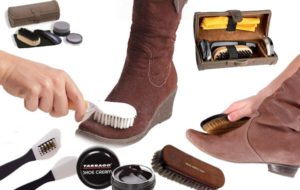 In spring and autumn care is as follows:
In spring and autumn care is as follows:
- clean immediately after returning home;
- if there is a need to wash your shoes, this should be done with cold or slightly warm water;
- minor dirt can be removed with a damp cloth;
- nubuck and suede can be cleaned with a brush;
- paper and special dryers are used for drying;
- To treat the surface, choose a cream of a suitable color or colorless; seams and folds are treated especially carefully; the composition is applied only to a dry surface.
Important! In the off-season, when the weather is especially unpredictable, a replacement pair of shoes is necessary. Regular glycerin or Vaseline will help to “seal” the seams; you can also carefully treat the joints with a water-repellent agent.
Don't forget about caring for your shoes in the summer. During the warmer months, it also requires cleaning and treatment with cosmetics. First of all, you need to protect the color from fading; there are special compounds for this. The second stage is protection from dust, this is primarily relevant for suede and textile shoes. Use impregnations that form a protective layer and do not allow dust to linger on the surface.
Important! Do not dry shoes in direct sunlight, preferably at room temperature.
In hot weather, you cannot do without talcum powder and deodorant for shoes, to prevent the appearance of an unpleasant odor, you need to regularly wash the insoles and treat them with hydrogen peroxide.
Leather shoes, like human skin, have a limited supply of moisture, so you need to moisturize them. The use of lotions and balms will protect the skin from drying out and cracking.
In winter, shoes are at greatest risk because they have to interact with chemicals and salt that are sprinkled on roads. You also have to deal with the negative effects of low temperatures. In winter, shoes require the following care:
- mandatory drying after each use;
- A brush or a special eraser will help get rid of salt and chemical reagents; white stains are removed with a napkin moistened with vinegar solution (vinegar and water are mixed in equal quantities);
- regularly apply water-repellent agents to the surface;
- In winter, leather shoes should be cleaned daily with water-repellent cream;
- Before leaving the house, apply wax or shoe polish to a previously cleaned surface.
Important! An excellent product that prevents the appearance of white streaks is a water-repellent spray.
Additional shoe care tips
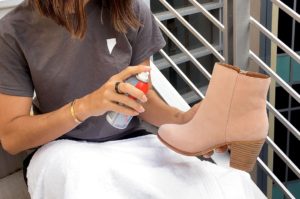 Recommendations:
Recommendations:
- Choose shoes according to size - this applies to fullness, insole length, and foot features. Otherwise, cracks will appear on the surface and the seams may come apart.
- Shoes should be worn in accordance with the season and weather conditions. In winter it is best to wear suede boots, but for spring and autumn it makes sense to choose a pair made of genuine leather. Textile shoes are only suitable for dry weather.
- Provide care immediately on the day of purchase. Before first use, shoes should be wiped with a soft cloth and a water-repellent compound should be applied.
- Put on and take off your shoes correctly - use a horn and fully unfasten the clasps.
- Regularly clean your shoes from dirt and dust and dry them for at least 12 hours.
- Use special impregnations and protective agents to protect against dust, fading, and also for moisture.
- Try to dry your skin at room temperature.
By following simple instructions, you can easily preserve the presentable appearance of your favorite pair of shoes and extend their service life.


 0
0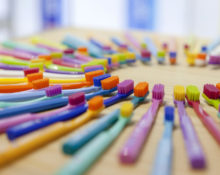
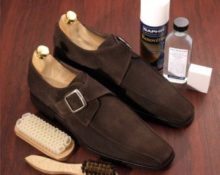
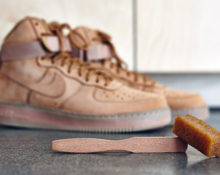
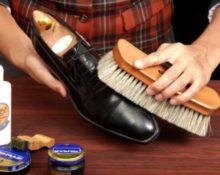

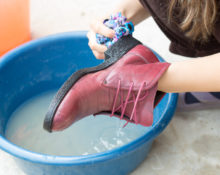

I have almost all Salton shoe care products, protection from water, reagents and salt. In reality, if you don’t skimp on such things, you can wear shoes for years and they will look good.
Before I put my shoes away until the next season, I always wash them first, then apply Salton cream and put them in the box, then the leather doesn’t dry out and the appearance doesn’t deteriorate.
I support the comments. This is my second year using Salton and Salton Expert products to care for my shoes. Creams, wax, water impregnations - everything is of high quality, it does not damage shoes (be it leather or textiles).